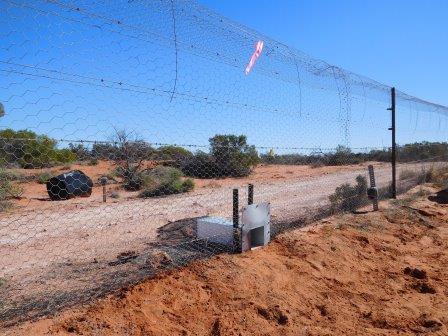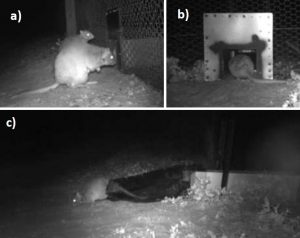Home /
News /
2016 /
Testing a simple solution to overabundance
Testing a simple solution to overabundance
Kate Butler
20 December 2016

This study not only looked at the number of Burrowing Bettongs to leave the Arid Recovery Reserve but also the number of bettongs investigating the gates, the influence of gate placement, how to optimise gate use via a food lure, the sex ratio of departing bettongs and also the distance travelled by a bettong to access the gate. Bettongs were cage trapped as they exited the gate to see if there was a bias in the animals that were using the gates. Also, radio collars were affixed to some bettongs before releasing them back into the Reserve in order to record the distance a bettong travelled to access a gate from their home territory.
Baiting the gates with peanut butter and oats as well as the landform placement (swale vs dune) both had effects on the use of the gates by the bettongs. Baiting increased the visits to the gate as well as the exits from the gate. Additionally, placing gates in dunes or corners of the fence rather than on interdunal swales also increased the visits to the gates. There was no difference in the number of males or females using the gates to exit the Reserve. The movements from the gate to the bettong’s burrow were wide ranging between 75m and 1.5km with an average of 418m.
 a) Curious bettongs investigating a one-way gate b) A bettong entering a one-way gate c) A bettong exiting on the other side
a) Curious bettongs investigating a one-way gate b) A bettong entering a one-way gate c) A bettong exiting on the other side
The optimal configuration for a gate was to be installed on a dune and baited with peanut butter and oats. In this configuration approximately one bettong, on average, exited per gate per night. No incursions by bettongs or feral animals into the Reserve through the one-way gates were recorded suggesting that the gates are working effectively in restricting traffic to one-way. The results presented in this study suggest that there is great potential for one-way gates to be implemented as an effective method of managing the over-abundance of Burrowing Bettongs at Arid Recovery.
One-way gates will reduce the costs and labour involved with other management techniques such as relocation of animals and will negate the need to cull an endangered species. A combination of techniques may be needed to successfully reduce the population to a capacity that the Arid Recovery Reserve can sustain.
 Kate Butler ready to install a one-way gate.
Kate Butler ready to install a one-way gate.